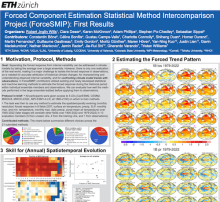Forced Component Estimation Statistical Methods Intercomparison Project (ForceSMIP): First Results
Robert
Jnglin Wills
ETH Zurich
Poster
Anthropogenic climate change is unfolding rapidly, yet its regional manifestation is often obscured by naturally occurring variability internal to the atmosphere and ocean system. A primary goal of climate science is to identify the forced response, i.e., spatiotemporal changes in climate in response to greenhouse gases, anthropogenic aerosols, and other external forcing, amongst the noise of internal climate variability. Separating the forced response from internal variability can be addressed in climate models by taking the average over a large ensemble, where the same model is run multiple times with small differences in initial conditions leading to different realizations of internal variability. However, there is only one realization of the real world, making it a major challenge to isolate the forced response in observations, as is needed for accurate attribution of historical climate changes, for characterizing and understanding observed internal variability, and for confronting climate model trends with observations.
In the Forced Component Estimation Intercomparison Project (ForceSMIP), contributors utilized existing and newly developed statistical and machine learning methods to estimate the forced response during the historical period within individual ensemble members and observations, across nine key climate variables (sea-surface temperature, surface air temperature, precipitation, sea-level pressure, sea-ice concentration, zonal-mean atmospheric temperature, monthly maximum and minimum temperature, and monthly maximum daily precipitation). Participants had access to five CMIP6 large ensembles on which to train their methods, but they then had to apply their methods to individual evaluation members, the identity of which was hidden to all participants. Participants used methods including regression methods, dynamical adjustment, artificial neural networks, linear inverse models, fingerprinting methods, and low-frequency component analysis, and all codes have been collected to make an open-access repository. The submission period ends on March 1, 2024, and we will present preliminary results showing how the different methods performed on climate models, what they assessed to the be the forced response in observations, and how the estimate of the forced response in observations compares with that in climate models.
In the Forced Component Estimation Intercomparison Project (ForceSMIP), contributors utilized existing and newly developed statistical and machine learning methods to estimate the forced response during the historical period within individual ensemble members and observations, across nine key climate variables (sea-surface temperature, surface air temperature, precipitation, sea-level pressure, sea-ice concentration, zonal-mean atmospheric temperature, monthly maximum and minimum temperature, and monthly maximum daily precipitation). Participants had access to five CMIP6 large ensembles on which to train their methods, but they then had to apply their methods to individual evaluation members, the identity of which was hidden to all participants. Participants used methods including regression methods, dynamical adjustment, artificial neural networks, linear inverse models, fingerprinting methods, and low-frequency component analysis, and all codes have been collected to make an open-access repository. The submission period ends on March 1, 2024, and we will present preliminary results showing how the different methods performed on climate models, what they assessed to the be the forced response in observations, and how the estimate of the forced response in observations compares with that in climate models.

Poster file
